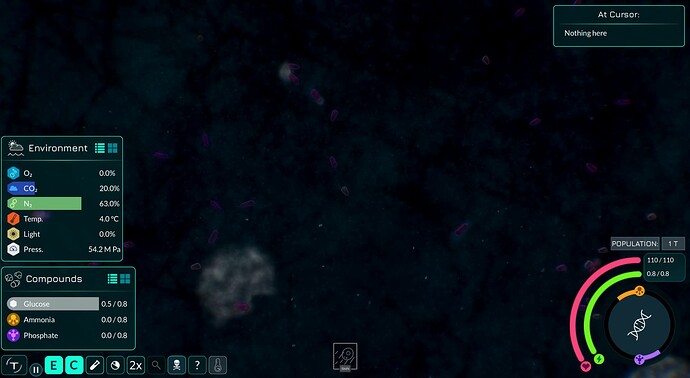Bit late on the Thermosynthesis things (I apparently didn’t notice the last patch),
but I decided to do a sessile playthrough with them and was surprised by the update.
This is on normal difficulty with no changes besides non-LAWK, on the latest version (0.8.2.1).
My first play started in the vents; I tried to figure out the new heat bar,
which I struggled to understand what was actually doing, even with the descriptive text.
At first I though the highest yellow bar was overheat and that I’d start taking damage, and that the green bar was ideal temperature.
Nope, that didn’t work, I knew in real-life a heat engine works off a gradient,
so I assumed that I had to move between hot and cold, and I got killed trying to do that.
I could still get to the editor, but it seemed like I was just loosing all my stamina the instant I was out of heat,
so I tried adding more storage to bandaid the issue.
Needless to say, I died horribly on that playthrough, before I went extinct just decided to start over.
My second attempt, I wanted to use thermosynthesis in the tide pool because that was my favorite place to use it in old versions.
In my third attempt, I started in the vents and migrated to the tide pool so I could use thermosynthase.
When I got there, I then assumed it was just the old system but with a noise map, and more heat over the background was just better;
this worked very well for the prokaryotic stage, with only a few random instances of just loosing all stamina for ‘no reason’.
I eventaully grinded up to a nucleus with that strategy, though most of my sister cells just died,
and I am glad that game kept my population reasonable (300) despite not being in a any niche the game recognized for that patch.
I think it helped that I decided to use cellulose so nothing had a niche to eat me up to the point.
Now, up to that point, I had thought ‘A glaciation event is going to kill me, isn’t?’ and then a glaciation event happened.
That editor cycle I (the player) moved back to the vent, and since I didn’t have any niches in the tidepool every cell there died.
Back in the vents with a functional build, I do fine until I sit still too long, then I disintegrate into chalk;
I finally figured out what was happening, I was overheating in dumbest possible way since if the that weird gradient bar
goes over the tiny white bar you no longer produce stamina, I think.
I’m still not sure how this system is supposed to actually work.
The problem is you will take damage to cool yourself since you can’t store anything,
you seem to gain a little stamina when cooling but it won’t be enough to get you back to working heat,
and if you go to the blue on the heat vision it will be way too cold and deal a ton of damage;
the best strategy I found was just to inch towards the center using the environment widget on the right,
and hope you didn’t get to the center before your health regenerated.
On thermal vision, it is useless;
at first I assumed that red/orange is hot and blue is cold, so I saw blue everywhere and assumed it was uniformly cold.
I then noticed there was blue and transparent (though this was barely visible with iron all over the screen),
so I assumed blue must be heat, and then realized it was No Color is heat.
Whenever there were clouds I had to toggle on and off to see what was different,
I think this feature just needs to turn them invisible when enabled, and maybe grey the background too.
I had to rely on the little thermometer in the environment widget to find good spots.
Despite the above, I did succeed this playthrough;
It was such a relief that when you bind to another cell with agents, it actually counts as a gradient between both, so as long it’s
not too cold you won’t take damage when moving around,
which allowed me to finally roam around after being constantly surrounded by invisible damage fields.
It was at the exact same time that auto-evo finally did something and let a bunch of prokaryotes use mucus,
which was entertaining fireworks.
And post-game (Multicellular) I decided to recreate the Heat-eater from this ancient Thrive promotional video:
which worked okay, and I used it to cross the sea floor and ice cap to reclaim the tide pool using Photosynthesis and some temporary midochondria,
but I made the mistake of removing too many midochondria from the tail (for “accuracy”) with thermoplasts in the river biome just before the pool,
which is 6 degrees colder than tidepool, and ended up a, not-death loop but actually more annoying unable to reproduce loop,
where I could survive with just the head, but then the tail would start dying and getting pecked by poison prokaryotes and die.
I tried to reload to the autosave in ice cap nearby, but autosaves aren’t in multicellular yet so that ended my playthrough.
I didn’t notice any outstanding visual problems with older features this patch (I use OpenGL),
though the sea floor is extraordinarily dark, this was a non-issue due to clouds still being visible and the player always being centered,
and I’m not sure if thermoplasts glowing is a feature or bug.
Edit: Also currents are a good addition, on a different playthrough they were a neat way to gain some speed or at least break up going in straight line; in the above playthrough they made some spots more challenging for thermo, particularly in the river.

